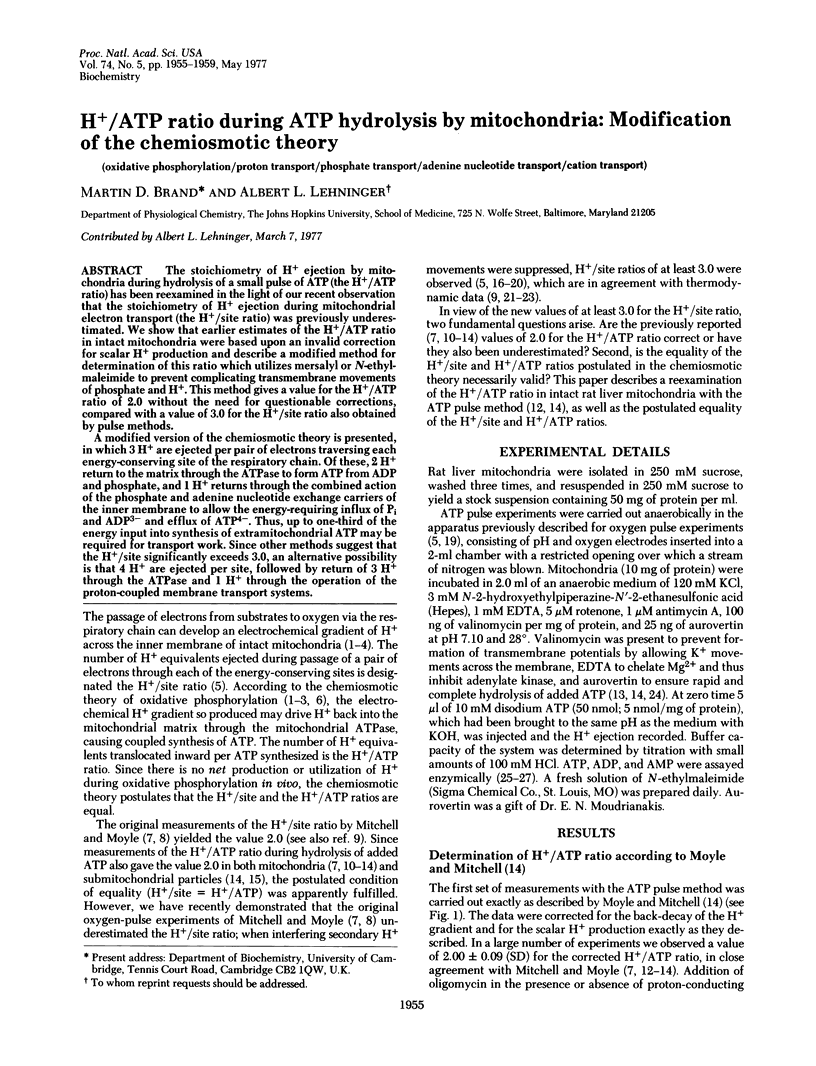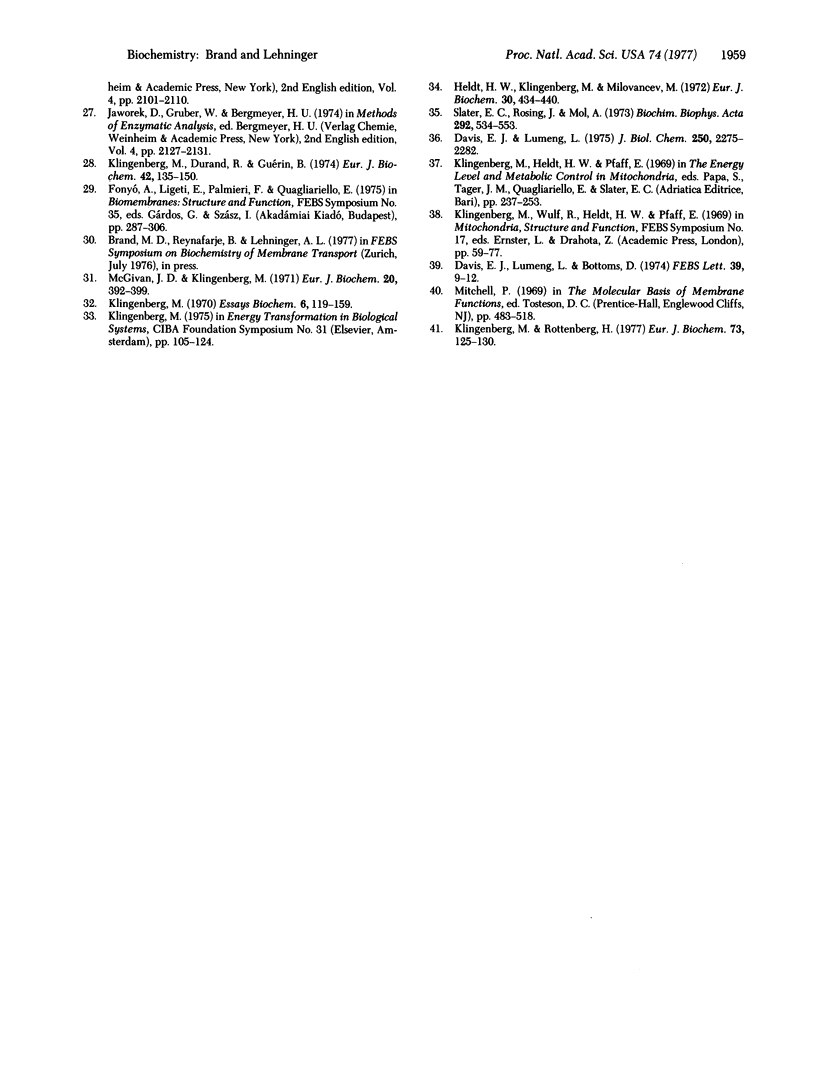Abstract
The stoichiometry of H+ ejection by mitochondria during hydrolysis of a small pulse of ATP (the H+/ATP ratio) has been reexamined in the light of our recent observation that the stoichiometry of H+ ejection during mitochondrial electron transport (the H+/site ratio) was previously underestimated. We show that earlier estimates of the H+/ATP ratio in intact mitochondria were based upon an invalid correction for scaler H+ production and describe a modified method for determination of this ratio which utilizes mersalyl or N-ethylmaleimide to prevent complicating transmembrane movements of phosphate and H+. This method gives a value for the H+/ATP ratio of 2.0 without the need for questionable corrections, compared with a value of 3.0 for the H+/site ratio also obtained by pulse methods. A modified version of the chemiosmotic theory is presented, in which 3 H+ are ejected per pair of electrons traversing each energy-conserving site of the respiratory chain. Of these, 2 H+ return to the matrix through the ATPase to form ATP from ADP and phosphate, and 1 H+ returns through the combined action of the phosphate and adenine nucleotide exchange carriers of the inner membrane to allow the energy-requiring influx of Pi and ADP3- and efflux of ATP4-. Thus, up to one-third of the energy input into synthesis of extramitochondrial ATP may be required for transport work. Since other methods suggest that the H+/site significantly exceeds 3.0, an alternative possibility is that 4 h+ are ejected per site, followed by return of 3 H+ through the ATPase and 1 H+ through the operation of the proton-coupled membrane transport systems.
Full text
PDF




Selected References
These references are in PubMed. This may not be the complete list of references from this article.
- Bielawski J., Lehninger A. L. Stoichiometric relationships in mitochondrial accumulation of calcium and phosphate supported by hydrolysis of adenosine triphosphate. J Biol Chem. 1966 Oct 10;241(19):4316–4322. [PubMed] [Google Scholar]
- Brand M. D., Chen C. H., Lehninger A. L. Stoichiometry of H+ ejection during respiration-dependent accumulation of Ca2+ by rat liver mitochondria. J Biol Chem. 1976 Feb 25;251(4):968–974. [PubMed] [Google Scholar]
- Brand M. D., Reynafarje B., Lehininger A. L. The H+/site ratio of mitochondrial electron transport. J Cell Physiol. 1976 Dec;89(4):595–602. doi: 10.1002/jcp.1040890415. [DOI] [PubMed] [Google Scholar]
- Brand M. D., Reynafarje B., Lehninger A. L. Re-evaluation of the H+/site ratio of mitochondrial electron transport with the oxygen pulse technique. J Biol Chem. 1976 Sep 25;251(18):5670–5679. [PubMed] [Google Scholar]
- Brand M. D., Reynafarje B., Lehninger A. L. Stoichiometric relationship between energy-dependent proton ejection and electron transport in mitochondria. Proc Natl Acad Sci U S A. 1976 Feb;73(2):437–441. doi: 10.1073/pnas.73.2.437. [DOI] [PMC free article] [PubMed] [Google Scholar]
- Davis E. J., Lumeng L., Bottoms D. On the relationships between the stoichiometry of oxidative phosphorylation and the phosphorylation potential of rat liver mitochondria as functions of respiratory state. FEBS Lett. 1974 Feb 1;39(1):9–12. doi: 10.1016/0014-5793(74)80004-9. [DOI] [PubMed] [Google Scholar]
- Ebel R. E., Lardy H. A. Influence of aurovertin on mitochondrial ATPase activity. J Biol Chem. 1975 Jul 10;250(13):4992–4995. [PubMed] [Google Scholar]
- Heldt H. W., Klingenberg M., Milovancev M. Differences between the ATP-ADP ratios in the mitochondrial matrix and in the extramitochondrial space. Eur J Biochem. 1972 Nov 7;30(3):434–440. doi: 10.1111/j.1432-1033.1972.tb02115.x. [DOI] [PubMed] [Google Scholar]
- Klingenberg M., Durand R., Guérin B. Analysis of the reactivity of SH-reagents with the mitochondrial phosphate carrier. Eur J Biochem. 1974 Feb 15;42(1):135–150. doi: 10.1111/j.1432-1033.1974.tb03323.x. [DOI] [PubMed] [Google Scholar]
- Klingenberg M. Metabolite transport in mitochondria: an example for intracellular membrane function. Essays Biochem. 1970;6:119–159. [PubMed] [Google Scholar]
- Klingenberg M., Rottenberg H. Relation between the gradient of the ATP/ADP ratio and the membrane potential across the mitochondrial membrane. Eur J Biochem. 1977 Feb 15;73(1):125–130. doi: 10.1111/j.1432-1033.1977.tb11298.x. [DOI] [PubMed] [Google Scholar]
- Lehninger A. L., Carafoli E., Rossi C. S. Energy-linked ion movements in mitochondrial systems. Adv Enzymol Relat Areas Mol Biol. 1967;29:259–320. doi: 10.1002/9780470122747.ch6. [DOI] [PubMed] [Google Scholar]
- MITCHELL P. Coupling of phosphorylation to electron and hydrogen transfer by a chemi-osmotic type of mechanism. Nature. 1961 Jul 8;191:144–148. doi: 10.1038/191144a0. [DOI] [PubMed] [Google Scholar]
- McGivan J. D., Klingenberg M. Correlation between H+ and anion movement in mitochondria and the key role of the phosphate carrier. Eur J Biochem. 1971 Jun 11;20(3):392–399. doi: 10.1111/j.1432-1033.1971.tb01405.x. [DOI] [PubMed] [Google Scholar]
- Mitchell P., Moyle J. Influence of aurovertin on affinity of mitochondrial adenosine triphosphatase for ATP and ADP. FEBS Lett. 1970 Feb 25;6(4):309–311. doi: 10.1016/0014-5793(70)80085-0. [DOI] [PubMed] [Google Scholar]
- Mitchell P., Moyle J. Proton translocation coupled to ATP hydrolysis in rat liver mitochondria. Eur J Biochem. 1968 May;4(4):530–539. doi: 10.1111/j.1432-1033.1968.tb00245.x. [DOI] [PubMed] [Google Scholar]
- Mitchell P., Moyle J. Respiration-driven proton translocation in rat liver mitochondria. Biochem J. 1967 Dec;105(3):1147–1162. doi: 10.1042/bj1051147. [DOI] [PMC free article] [PubMed] [Google Scholar]
- Mitchell P., Moyle J. Stoichiometry of proton translocation through the respiratory chain and adenosine triphosphatase systems of rat liver mitochondria. Nature. 1965 Oct 9;208(5006):147–151. doi: 10.1038/208147a0. [DOI] [PubMed] [Google Scholar]
- Moyle J., Mitchell P. Proton translocation quotient for the adenosine triphosphatase of rat liver mitochondria. FEBS Lett. 1973 Mar 15;30(3):317–320. doi: 10.1016/0014-5793(73)80678-7. [DOI] [PubMed] [Google Scholar]
- Nicholls D. G. The influence of respiration and ATP hydrolysis on the proton-electrochemical gradient across the inner membrane of rat-liver mitochondria as determined by ion distribution. Eur J Biochem. 1974 Dec 16;50(1):305–315. doi: 10.1111/j.1432-1033.1974.tb03899.x. [DOI] [PubMed] [Google Scholar]
- Papa S. Proton translocation reactions in the respiratory chains. Biochim Biophys Acta. 1976 Apr 30;456(1):39–84. doi: 10.1016/0304-4173(76)90008-2. [DOI] [PubMed] [Google Scholar]
- Reynafarje B., Brand M. D., Lehninger A. L. Evaluation of the H+/site ratio of mitochondrial electron transport from rate measurements. J Biol Chem. 1976 Dec 10;251(23):7442–7451. [PubMed] [Google Scholar]
- Rossi C. S., Siliprandi N., Carafoli E., Bielawski J., Lehninger A. L. Proton movements across the mitochondrial membrane supported by hydrolysis of adenosine triphosphate. Eur J Biochem. 1967 Oct;2(3):332–340. doi: 10.1111/j.1432-1033.1967.tb00143.x. [DOI] [PubMed] [Google Scholar]
- Rottenberg H. The measurement of transmembrane electrochemical proton gradients. J Bioenerg. 1975 May;7(2):61–74. doi: 10.1007/BF01558427. [DOI] [PubMed] [Google Scholar]
- Slater E. C., Rosing J., Mol A. The phosphorylation potential generated by respiring mitochondria. Biochim Biophys Acta. 1973 Apr 5;292(3):534–553. doi: 10.1016/0005-2728(73)90003-0. [DOI] [PubMed] [Google Scholar]
- Thayer W. S., Hinkle P. C. Stoichiometry of adenosine triphosphate-driven proton translocation in bovine heart submitochondrial particles. J Biol Chem. 1973 Aug 10;248(15):5395–5402. [PubMed] [Google Scholar]


